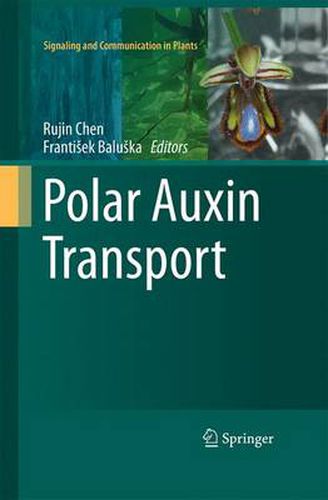Readings Newsletter
Become a Readings Member to make your shopping experience even easier.
Sign in or sign up for free!
You’re not far away from qualifying for FREE standard shipping within Australia
You’ve qualified for FREE standard shipping within Australia
The cart is loading…






This title is printed to order. This book may have been self-published. If so, we cannot guarantee the quality of the content. In the main most books will have gone through the editing process however some may not. We therefore suggest that you be aware of this before ordering this book. If in doubt check either the author or publisher’s details as we are unable to accept any returns unless they are faulty. Please contact us if you have any questions.
The importance of the plant growth regulator auxin for plant growth has long been recognized, even before the discovery of its chemical structures in the early 20th century. Physiological studies in the decades since have demonstrated that auxin is unidirectionally transported in plants, a process dubbed polar auxin transport. It is the polar auxin transport process that generates a local auxin concentration gradient and regulates a broad array of physiological and developmental processes. The discoveries of auxin transport carrier proteins that mediate auxin influx into and efflux out of transport-competent cells and auxin receptor proteins for auxin signaling in the last few decades represent significant milestones in auxin research and open up opportunities to probe the cellular and molecular processes that regulate auxin transport and integrate environmental cues with signaling processes. Remarkably, components of the polar auxin transport machinery are present in both lower plants such as mosses and higher plants including monocots and eudicots, illustrating the key role of polar auxin transport in plant evolution. This book highlights topics ranging from physiological and genetic studies of polar auxin transport in plant development, to growth responses to the environment and plant-microbe interactions, to hormonal cross-talks with various cellular and molecular regulatory processes essential for polar auxin transport.
$9.00 standard shipping within Australia
FREE standard shipping within Australia for orders over $100.00
Express & International shipping calculated at checkout
This title is printed to order. This book may have been self-published. If so, we cannot guarantee the quality of the content. In the main most books will have gone through the editing process however some may not. We therefore suggest that you be aware of this before ordering this book. If in doubt check either the author or publisher’s details as we are unable to accept any returns unless they are faulty. Please contact us if you have any questions.
The importance of the plant growth regulator auxin for plant growth has long been recognized, even before the discovery of its chemical structures in the early 20th century. Physiological studies in the decades since have demonstrated that auxin is unidirectionally transported in plants, a process dubbed polar auxin transport. It is the polar auxin transport process that generates a local auxin concentration gradient and regulates a broad array of physiological and developmental processes. The discoveries of auxin transport carrier proteins that mediate auxin influx into and efflux out of transport-competent cells and auxin receptor proteins for auxin signaling in the last few decades represent significant milestones in auxin research and open up opportunities to probe the cellular and molecular processes that regulate auxin transport and integrate environmental cues with signaling processes. Remarkably, components of the polar auxin transport machinery are present in both lower plants such as mosses and higher plants including monocots and eudicots, illustrating the key role of polar auxin transport in plant evolution. This book highlights topics ranging from physiological and genetic studies of polar auxin transport in plant development, to growth responses to the environment and plant-microbe interactions, to hormonal cross-talks with various cellular and molecular regulatory processes essential for polar auxin transport.